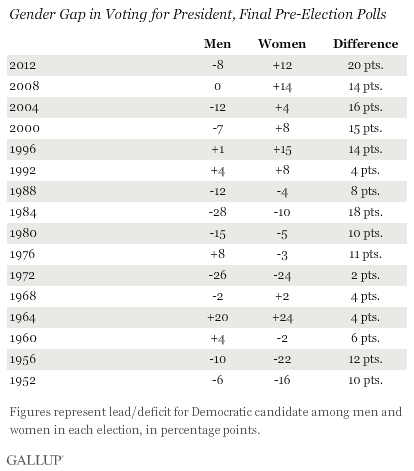PRINCETON, NJ -- President Barack Obama won the two-party vote among female voters in the 2012 election by 12 points, 56% to 44%, over Republican challenger Mitt Romney. Meanwhile, Romney won among men by an eight-point margin, 54% to 46%. That total 20-point gender gap is the largest Gallup has measured in a presidential election since it began compiling the vote by major subgroups in 1952.

Notably, Obama's 12-percentage-point advantage among women is slightly less than the 14-point advantage he had over John McCain in 2008, while Romney improved on McCain's performance among men by eight points. Thus, the narrowing of Obama's winning margin between the two elections, from seven points to two points, can be ascribed mainly to men's shifting more Republican.
Gallup's historical estimates of the gender gap are based on its final pre-election estimate of the major candidate vote for each election, with the results adjusted, if necessary, to correct for any difference between Gallup's pre-election estimate of the vote and the actual election results. In the 2012 election, Gallup's final unallocated estimate of the vote, based on Nov. 1-4 tracking, showed Obama favored by 48% of likely voters and Romney by 49%. Thus, for this analysis, Obama's support among men and women was weighted upward slightly to match his actual 50% support in the election, and Romney's was weighted downward to match his 48% support level.
The gender gap has been evident in presidential voting since at least 1952, though it tended to be somewhat muted in the 1960-1972 elections, averaging just four points. Two of those elections, 1964 and 1972, were landslide victories for incumbent presidents. The other two were highly competitive contests.
Prior to this year, the largest gender gap in Gallup polling history was 18 points in the 1984 election that saw Republican Ronald Reagan win a second term in office. Majorities of both men and women voted for Reagan in that election, but he won among men by 28 points (64% to 36%) and among women by 10 points (55% to 45%). It is unclear to what extent the presence on the Democratic ticket of Geraldine Ferraro, the first woman to be a major party's nominee for vice president, had on the vote of women that year.
Women have supported the Democratic candidate in each of the last six elections. Men favored the Democrat in only two of the last six -- 1992 and 1996 -- and in only four of the 16 elections since 1952.
Overall, since 1952, men and women have differed as to the party's candidate they favored six times, including 1960, 1968, 1976, 2000, 2004, and 2012. In 2008, McCain ran even among men, while women preferred Obama by a large margin.
Implications
The gender gap continues to be a significant factor in U.S. presidential elections, and the preferences of men and women have never differed more than in the 2012 election. There are a number of possible reasons for the increase in the gender gap this year. For example, Romney's business background may have been more appealing to men than to women. Obama's campaign stressed maintaining the social safety net, raising taxes on the wealthy, maintaining abortion rights, and requiring healthcare coverage for contraception -- all in contrast to Romney's more conservative positions on these issues of potential interest to women.
The Democratic Party will likely attempt to secure Obama's election advantage among women by carrying forward the themes that seemed to work in future elections at all levels of government. It remains to be seen whether and how the Republican Party will change course to try to broaden its appeal to women without forfeiting the strong support of men.
Survey Methods
Results for this Gallup poll are based on telephone interviews conducted Nov. 1-4, 2012, on the Gallup Daily election tracking survey, with a random sample of 2,551 likely voters, aged 18 and older, living in all 50 U.S. states and the District of Columbia.
For results based on the total sample of likely voters, one can say with 95% confidence that the maximum margin of sampling error is ±2 percentage points.
For results based on 1,337 female likely voters, the maximum margins of sampling error are ±3 percentage points.
For results based on 1,214 male likely voters, the maximum margins of sampling error are ±4 percentage points.
Interviews are conducted with respondents on landline telephones and cellular phones, with interviews conducted in Spanish for respondents who are primarily Spanish-speaking. Each sample includes a minimum quota of 250 cellphone respondents and 250 landline respondents per 500 national adults, with additional minimum quotas among landline respondents by region. Landline telephone numbers are chosen at random among listed telephone numbers. Cellphone numbers are selected using random-digit-dial methods. Landline respondents are chosen at random within each household on the basis of which member had the most recent birthday.
Samples are weighted by gender, age, race, Hispanic ethnicity, education, region, adults in the household, population density, and phone status (cellphone only/landline only/both, cellphone mostly, and having an unlisted landline number). Demographic weighting targets are based on the March 2011 Current Population Survey figures for the aged 18 and older non-institutionalized U.S. population. All reported margins of sampling error include the computed design effects for weighting.
In addition to sampling error, question wording and practical difficulties in conducting surveys can introduce error or bias into the findings of public opinion polls.
For more details on Gallup's polling methodology, visit www.gallup.com.
